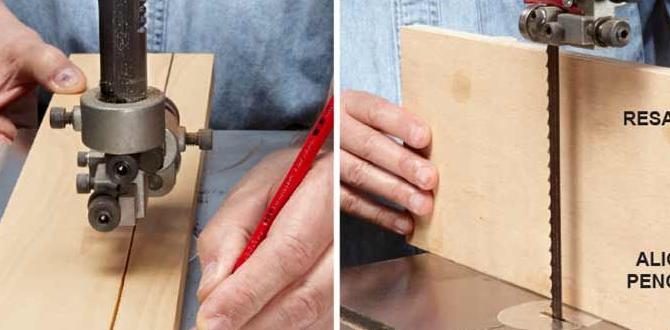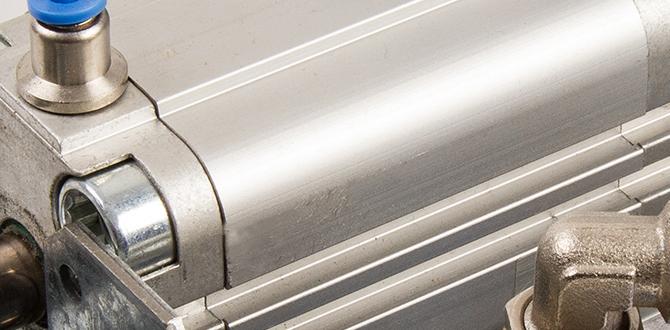Don’t let nailer misfires slow you down! Common culprit are low air pressure, dull driver blades, and debris. This guide provides simple, expert fixes to get your pneumatic nailer firing perfectly again, ensuring smooth project completion.
Hello there, fellow DIYer! Jack Shaffer here from Nailerguy. If you’ve ever been in the middle of a project, ready to sink a nail, and your trusty pneumatic nailer just… sighs… weakly, you’re not alone. It’s a frustrating moment that can halt your progress and put a damper on your creative flow. But don’t worry! Misfires in pneumatic nailers are a common issue, and most of the time, they have simple, fixable causes.
Think of your nailer like any other tool; it needs the right conditions to work its best. When it doesn’t perform, it’s usually a sign that something basic is a little off. We’re going to walk through the most common reasons why your nailer might be misfiring, providing straightforward solutions that you can tackle yourself. We’ll cover everything from air pressure issues to simple maintenance tips. By the end of this, you’ll have the know-how to troubleshoot and fix most misfiring problems, getting you back to building with confidence. Let’s dive in and get your nailer singing again!
Table of Contents
Understanding Pneumatic Nailer Misfires
A “misfire” in a pneumatic nailer can mean a few things. It might be that the nailer doesn’t drive the nail all the way in, leaving it sticking out. Sometimes, it might not drive the nail at all, or it might even jam. These are all signals that your nailer isn’t getting the power or the clear path it needs to do its job. Understanding these little hiccups is the first step to fixing them.
The Basics of How a Pneumatic Nailer Works
Before we jump into troubleshooting, it’s helpful to know how these tools work. Pneumatic nailers use compressed air to drive nails. When you pull the trigger, a piston is forcefully pushed forward by the air pressure. This piston strikes the top of the nail, driving it into your material. A sophisticated system of seals and valves controls this air flow, ensuring a controlled and powerful strike. When something disrupts this process, you get a misfire.
Why This Happens to Beginners (And Even Pros!)
It’s easy for beginners to overlook simple things like air pressure or tool maintenance. But even experienced woodworkers can encounter misfires, especially when using different tools, different types of nails, or working in varying conditions. The good news is, these aren’t usually signs of a broken tool, but rather a need for attention to its operational needs.
Common Reasons for Misfires in Pneumatic Nailers
Let’s get down to brass tacks. Here are the most frequent culprits behind those frustrating misfires:
1. Insufficient Air Pressure
This is by far the most common reason for nailer misfires, especially for beginners. Pneumatic nailers need a specific range of air pressure to operate correctly. If the pressure is too low, the piston won’t have enough force to drive the nail fully.
How to Check: Most nail guns have a setting on the air compressor’s regulator that shows the current pressure. Your nailer’s manual will specify the recommended operating pressure. Typically, this falls between 70-120 PSI (pounds per square inch), but it can vary significantly by model.
Common Causes of Low Pressure:
The regulator on the compressor set too low.
A long or thin air hose causing pressure drop over the distance.
Leaks in the air hose, fittings, or even the nailer itself.
The air compressor tank not being fully charged.
The Fix:
Adjust the Regulator: Turn up the pressure on your air compressor’s regulator to the recommended level for your nailer.
Use the Right Hose: Use an air hose of adequate diameter (usually 3/8 inch or 1/2 inch for most DIY applications) and don’t use excessively long runs if you can avoid it.
Check for Leaks: Listen for hissing sounds. Use soapy water on connections; if bubbles form, you have a leak. Tighten fittings or replace damaged hoses/couplers. You can find helpful tips on troubleshooting air leaks from resources like the U.S. Department of Labor’s Occupational Safety and Health Administration (OSHA) regarding compressed air safety.
Ensure Full Tank: Let your compressor build up to its full pressure.
2. Air Leaks
Even if your regulator is set correctly, leaks anywhere in the pneumatic system will reduce the effective pressure reaching the nailer’s driver mechanism.
Where to Look:
Hose Connections: Where the hose connects to the compressor and the nailer.
Couplers/Fittings: The quick-release couplings used to attach the hose.
The Air Hose Itself: Look for cracks or damage.
Nailer O-rings and Seals: These can wear out over time.
The Fix:
Tighten loose fittings.
Replace worn-out or damaged couplers.
If the hose is cracked, replace it.
For nailer seal leaks, consult your nailer’s manual regarding seal kits or seek professional repair if you’re not comfortable.
3. Debris or Obstructions in the Airpath or Magazine
Just like a gun needs a clean barrel, a nailer needs a clear path for its air and its nails.
Obstructions in the Magazine: If nails aren’t loaded correctly, or if there’s sawdust or debris in the magazine, the nail might not present itself properly to the driver blade. This can cause jams or failed drives.
Obstructions in the Airpath: Small pieces of debris can sometimes get into the air chambers of the nailer and impede the piston’s movement.
The Fix:
Unload and Inspect the Magazine: Remove any jammed nails or debris. Ensure nails are loaded cleanly and straight.
Cycle the Tool: With no air connected, repeatedly actuate the safety tip and trigger (carefully, as it won’t drive nails without air, but it can sometimes dislodge minor obstructions).
Clean the Nailer: Refer to your nailer’s manual for specific cleaning instructions. Compressed air can often be used to blow out debris from accessible ports.
4. Worn or Damaged Driver Blade (or Piston)
The driver blade, sometimes called the piston or ram, is the part that actually strikes the nail. If it becomes dull, bent, or chipped, it won’t transfer energy effectively to the nail.
Signs of Damage: Visually inspect the tip of the driver blade. Does it look sharp and flat, or is it rounded, chipped, or bent?
The Fix:
Disassembly Required: This often requires disassembling the nose of the nailer. Consult your owner’s manual for specific instructions.
Replacement: If the driver blade is damaged, it will need to be replaced. Replacement parts are usually available from the tool manufacturer or specialized distributors. For many common brands, you can find repair guides and parts online with a quick search. For example, a site like ToolPartsDirect.com often has diagrams and parts for many tool brands.
Professional Repair: If you’re not confident in disassembling the tool, take it to a qualified tool repair shop.
Table: Nailer Misfire Symptoms and Potential Causes
This table provides a quick reference for common problems.
Symptom
Most Likely Cause(s)
Simple Fixes to Try First
Nail not driven all the way in.
Low air pressure, worn driver blade, insufficient air supply.
Increase air pressure, check air supply.
Nailer fires but no nail is driven.
Debris in air path, jammed nail in magazine, worn driver blade.
Clear magazine, cycle tool (no air), inspect for obstructions.
Nailer jams frequently.
Incorrect nail size/type, debris in magazine, bent driver blade.
Ensure correct nails are used, clean magazine, inspect driver assembly.
Nailer fires erratically (sometimes works, sometimes not).
Intermittent air leak, low air pressure, dirty internal components.
Check for leaks, adjust pressure, perform basic cleaning.
5. Incorrect Nail Type or Size
Nailers are designed for specific types and sizes of nails (or staples). Using the wrong ones can cause feeding issues and misfires.
Why It Matters: If nails are too long, too short, too thick, or too thin for the magazine or driver mechanism, they won’t feed properly. They might jam, or they might not line up correctly to be struck by the driver.
The Fix:
Consult Your Manual: Always check your nailer’s manual to confirm the exact type and size range of fasteners it accepts.
Use Quality Nails: Stick to reputable brands of nails. Sometimes, cheaper nails have slight variations that can cause feeding problems.
6. Dry Firing the Nailer Without Lubrication
Most pneumatic nailers require occasional lubrication to keep their internal components moving smoothly. Running the tool extensively without lubrication, often called “dry firing” (even with air pressure, but no nails being driven), can cause wear and misfires.
The Importance of Lubrication: A few drops of specialized pneumatic tool oil in the air inlet port (when the air is disconnected!) keeps seals pliable and the piston reciprocating smoothly. This prevents friction and wear.
The Fix:
Lubricate Regularly: Follow your tool’s manual for the recommended lubrication schedule and procedure. Typically, it’s a few drops of oil every day of heavy use or weekly for lighter use.
Use the Correct Oil: Never use WD-40 or other solvent-based lubricants; use dedicated pneumatic tool oil. You can find this at most hardware stores and online retailers. Resources like Grainger often have a wide selection of pneumatic tool lubricants.
7. Dirty or Gummed-Up Internal Components
Over time, dust, old oil, and debris can build up inside the nailer’s air chambers and piston assembly. This can restrict movement and lead to misfires.
What to Look For: If you notice the nailer feels sluggish even with proper air pressure, or if there’s a noticeable loss of power, internal gunk might be the culprit.
The Fix:
Regular Cleaning: Some nailers can be partially disassembled for cleaning. Again, check your manual. Using a small brush and compressed air can help remove loose debris.
Deep Cleaning/Service: For a more thorough cleaning, you might need to take the nailer apart further or send it in for professional servicing. Some manufacturers offer maintenance kits.
8. The Safety Contact Trip (Nose Safety) Issues
The “safetly contact trip” or “safety tip” is the part at the nose of the nailer that must be pressed against the work surface before the trigger will fire a nail. If this mechanism is faulty, dirty, or stuck, it can prevent the nailer from firing correctly, leading to misfires or no firing at all.
How it Works: When you press the nose against the material, it depresses a plunger. This plunger is part of a system that allows the trigger mechanism to function.
Problems:
Stuck Plunger: Debris can cause the plunger to stick in the “pressed” or “unpressed” position.
Worn Spring: The spring that retracts the plunger might weaken.
Damage: The mechanism could be physically damaged.
The Fix:
Inspect and Clean: Carefully inspect the safety contact trip. Try to pull it out if it seems stuck. Use compressed air and a soft brush to clean around it.
Lubrication: Sometimes a tiny bit of lubricant can free up a sticky plunger.
Professional Check: If you can’t get it to move freely, it may need professional repair.
Troubleshooting Steps: A Practical Guide
So, your nailer is acting up. What do you do first? Follow these steps in order to diagnose and fix the problem.
Step 1: Check the Air Supply
This is your first and most important check.
1.
Ensure Compressor is Charged: Make sure your air compressor tank has sufficient air pressure.
2. Check Regulator Setting: Verify that the regulator on your compressor is set to the recommended PSI for your nailer (refer to your nailer’s manual).
3. Inspect Air Hose: Look for obvious damage. Ensure all connections are tight.
Step 2: Inspect the Nailer’s Magazine and Feed Mechanism
Clear and clean for best results.
1.
Remove Air: Disconnect the air hose from the nailer.
2. Unload Nails: Completely unload the magazine.
3. Look for Jams: Carefully check for any bent or jammed nails. Remove them gently.
4. Remove Debris: Blow out any dust or debris from the magazine with compressed air.
5. Cycle the Safety: While keeping your fingers away from the trigger and the nose, press and release the safety contact trip a few times. Ensure it moves freely.
Step 3: Perform Basic Functionality Test (with caution!)
Reconnect air and test with a scrap piece of wood.
1.
Reconnect Air: Reattach the air hose, ensuring connections are secure.
2. Set to Target Pressure: Adjust your compressor regulator to the correct operating pressure.
3. Test Fire: Place the nailer nose firmly against a scrap piece of wood. Pull the trigger. Observe the nail drive.
Step 4: Re-evaluate and Deepen Troubleshooting if Needed
If it’s still misfiring, it’s time to look deeper.
Still Not Driving Fully? Likely air pressure or internal mechanism issue.
Still Jamming? Could be the wrong nails, debris, or a feeding mechanism problem.
Intermittent Issues? Often points to air leaks or a component that’s about to fail.
Step 5: Lubrication and Further Cleaning
If your nailer hasn’t been lubricated recently, or if you suspect internal build-up.
1.
Lubricate: Disconnect air. Add 2-3 drops of pneumatic tool oil into the air inlet port. Reconnect air and fire a few nails into scrap wood to distribute the oil.
2. Clean Nose Assembly: If the nose assembly is accessible according to your manual, try cleaning it more thoroughly.
Step 6: Consult Manual or Seek Professional Help
If the problem persists after these steps, it might be time to consult your nailer’s manual for advanced troubleshooting or contact a professional repair service. You can often find downloadable manuals on the manufacturer’s website. For example, if you own a DeWalt nailer, searching “DeWalt nailer manual” will usually lead you to their support page.
Maintenance for Preventing Misfires
The best way to deal with misfires is to prevent them in the first place! Regular, simple maintenance goes a long way.
Daily/Weekly Checks (Depending on Use)
Visual Inspection: Check the air hose, fittings, and nailer body for any signs of damage or wear.
Cleanliness: Wipe down your nailer, especially the nose and magazine, to remove dust and debris.
Lubrication: Add a few drops of oil to the air inlet if you’re using it regularly.
Monthly Checks
Air Filter: If your compressor has an air filter, check and clean or replace it as needed. A clogged filter can restrict airflow.
O-rings and Seals: Inspect visible O-rings and seals for cracks or dryness.
Annual Servicing
Deep Clean: Consider a more thorough internal cleaning or servicing.
Professional Check-up: For heavy users, a professional tune-up once a year can catch potential issues before they become major problems.
When to Call a Professional
While many nailer issues are DIY-friendly, there are times when it’s best to let an expert handle it.
Persistent Misfires: If you’ve tried all the common fixes and the problem persists.
Stuck Pistons or Jams: If you can’t clear a jam or the piston seems completely seized.
Damaged Internal Parts: If you suspect major internal damage (e.g., a broken driver blade you can’t replace easily).
* Lack of Confidence:** If you’re not comfortable disassembling or working on the tool.
A qualified tool repair shop can diagnose complex issues and perform necessary repairs, ensuring your tool is safe and reliable.
Conclusion
There you have it! A pneumatic nailer misfiring can be a real puzzle, but by understanding the common causes and following these troubleshooting steps, you can get back to your projects with confidence. Most issues boil down to simple things like air pressure, a clean workspace for your fasteners, and a bit of regular maintenance.
Remember, a well-maintained tool is a happy tool, and a happy tool means successful projects for you. So, don’t let those frustrating misfires win. With a little bit of know-how and these expert tips, you’re well-equipped to diagnose, fix,



